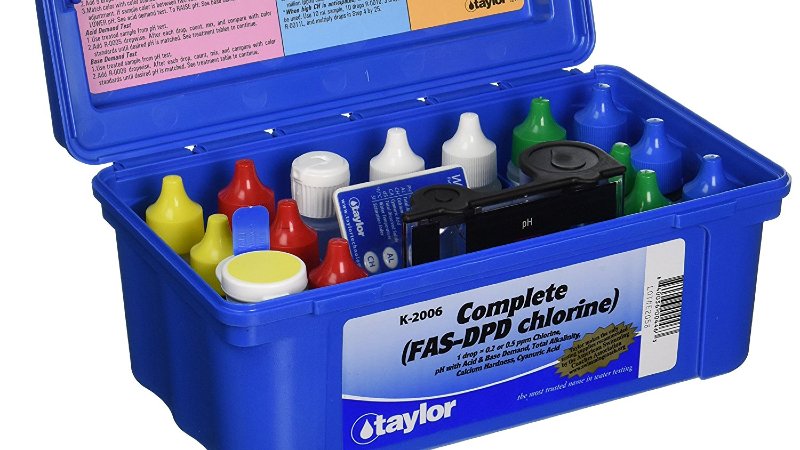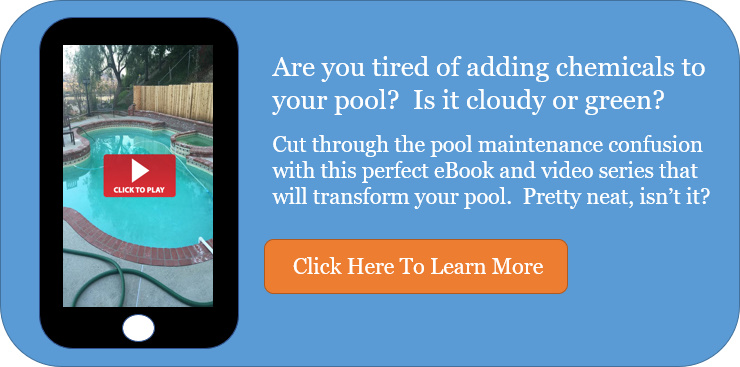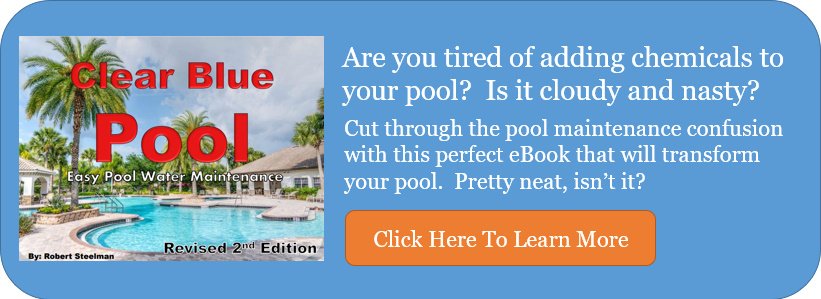Easy Guide To Basic Pool Chemistry and Have A Clear Pool
Even if you’ve recently purchased a swimming pool, are thinking about doing so, or have had a pool for many years, you've heard about pool chemistry. Maintaining the right chemistry in your pool water is one of the most important aspects of having a crystal clear and safe pool.
All it takes is a basic pool chemistry knowledge, the right supplies, and a desire to keep your pool perfect all swimming season.

Pool Chemicals Are The Key To A Clean Pool
You have everything ready for a great Summer, right? Pool is filled up? Filter running? Leaf rake and vacuum? Maybe some chlorine tabs? But one thing that might be a bit confusing is what chemicals to put in and when. Don't worry. We have you covered. Proper pool chemistry is the most important part of your pool care. It shouldn't take hundreds of hours and tons of money to take care of and balance a home pool. Far from it. This is not complex chemistry, but it does take a basic understanding of what you need to know for swimming pool care.
Your Pool Sanitizer
Your pool sanitizer has three functions and they are to:
- Oxidize
- Sanitize
- Kill organic matter in the pool
Regardless of your choice of sanitizer, you'll want to make sure these three areas are covered. Now, for the types of sanitizers you'll find.
What Is Chlorine?
Chlorine is by far the most popular type of sanitizer due to its low cost, availability, and efficacy. Chlorine is also highly effective at killing algae spores, bacteria, and pathogens that may enter your pool water. Chlorine can be found in 3 forms and they are:
Granules: Unstabilized chlorine granules are calcium hypochlorite and stabilized forms of chlorine are dichlor and trichlor.
Liquid: This is sodium hypochlorite and my preferred chlorine product. It's unstabilized and great for weekly maintenance.
Tablets: You can find chlorine tablets in 1 inch and 3 inch sizes. Chlorine tablets are meant to dispense 1 ppm chlorine per day so your chlorine doesn't bottom out. You'll want to maintain your chlorine level between 2 - 4 ppm. Test your chlorine twice per week and add enough chlorine to maintain the proper level.
What Is Stabilized Chlorine?
Stabilized chlorine is one of those tricky types of chlorine and should only be used in certain circumstances. These types of chlorine go by the name Dichloro-S-Triazinetrione, or dichlor, and TriChloro-S-Triazinetrione, or trichlor. If you see these name on bags of shock in your pool store, you're getting stabilized chlorine. You should NEVER use stabilized chlorine for weekly maintenance and weekly shocking of your pool. Stabilized chlorine has CYA (cyanuric acid) in it. When you add stabilized chlorine to your pool, you're also dosing it with CYA. You should only use stabilized chlorine when:
- You have a newly filled pool
- When you need to get BOTH chlorine AND stabilizer into your pool quickly
- After a heavy rain
- Anything else that would cause your CYA to decrease
If your CYA gets too high, the best and long term solution is to do a partial drain and refill. If it's too high, a full drain and refill might be needed.
What Are Chloramines?
Chloramines are a byproduct of your pool chlorine oxidizing organic matter and nitrogen-based compounds. This is referred to as disinfectant byproducts and gives you that "chlorine smell" when you visit a public pool, especially an indoor pool. When the pool chemicals in a home pool are properly balanced, you should not have that "chlorine smell". In my 20+ years of being in the pool industry and having cleared up over 700 pools in 3 different states, I can count on one hand the amount of times I've had a chlorine smell at a home pool. Simply by adding enough chlorine to your pool to maintain a chlorine level of 2 - 4 ppm, your pool will have more than enough sanitizer to kill the organic matter.
What Is Pool pH?
pH is a measurement of whether a substance is basic or acidic. The pH scale ranges from 0 to 14, with 7 being neutral. Anything below 7 is acidic and everything above 7 is considered basic. pH also plays an important factor in how effective your chlorine is. The higher the pH, the less effective your chlorine is. And less effective chlorine opens the door to green pool water, other forms of algae and bacteria.
To increase your pH, soda ash is a great alternative. So is Arm & Hammer Washing Soda. As for lowering your pH level, you have muriatic acid and dry acid which is commonly known as pH Down. The active ingredient in granular pH Down is sodium bisulfate. The optimal pH level in your pool is a very forgiving range of 7.2 - 7.8.
What Is Pool Alkalinity?
Your pool's alkalinity is an alkaline substance and acts as a buffer which inhibits changes in your pool's pH. Alkalinity is a measurement of the buffering ability in pool water. The recommended alkalinity level for swimming pool water is 80-120 ppm. When your pool water has low alkalinity, below 80 ppm, it's recommended that this level be increased. You can accomplish this with regular grocery store sodium bicarbonate, or baking soda. A generic brand works just as well as name brand baking soda. To lower your pool alkalinity, you can either use muriatic acid or dry acid which is known as sodium bisulfate.
What Is Calcium Hardness?
Along with your pool's pH and alkalinity, your calcium hardness must be managed to keep your pool water in proper chemical balance. Calcium hardness is the measurement of how hard or soft your pool water is. The higher the hardness, the harder the water. The lower the calcium hardness is, the softer the water is. If the calcium hardness is too high, coupled with sustained high pH, it can lead to scaling and the calcifying of your pool equipment. If the hardness is too low, it can lead to pitting of your plaster. You will want to maintain your calcium hardness between 150 - 250 ppm. The product you use to increase your calcium hardness is calcium chloride.
What Is CYA?
Cyanuric acid (CYA) is probably the most important of all your pool chemicals. You may have heard it go by other names such as “pool stabilizer” or “pool conditioner”. You can get it in either liquid or granular form. It can also be found in chlorine tablets or sticks (also called trichlor) and in chlorine shock (called dichlor).
Most of the chlorine we add to our pools is unstabilized, meaning, it has no stabilizer in it. Our chlorine needs help in order to be effective. That's where CYA comes in handy. It allows our chlorine to be as effective as it can be in order to kill algae spores and other organic matter in the pool.
Your CYA level should read between 30 - 50 ppm. Salt pools can have a slightly higher CYA of 70 ppm.
What Are Some Other Pool Chemicals I Might Need?
As with everything in life, we need a little help sometimes. Maybe your pool is a bit cloudy and you want to clear it up fast. Or perhaps you're busy and need some backup in case you can't get to your pool. Well, this has you covered.
What Is An Algaecide?
Your chlorine kills the algae and bacteria in your pool. But life happens. Things happen. So what can you do about it? Add a good PolyQuat 60 algaecide. You see, algaecides act as a backup, so to speak, against another algae bloom. Just in case your chlorine level gets too low, the algaecide kicks in and stops the spread of algae.
If you have metals in your water, or are on well water, it's best if you stay away from silver or copper based algaecides. You're not helping your pool by adding more metal to the water. A good PolyQuat 60 algaecide is all you'll need.
What Is A Clarifier and Flocculant?
Two different words. Two different meanings. A clarifier is added to your pool and makes smaller particles larger so they can easily get filtered out. A clarifier is good to have on hand if your filter needs a little more help in getting those smaller particles. Or if you have a Saturday swim party and want your pool to POP just a little more. Understand that a clarifier won't treat the cause, only the symptom if your pool is really cloudy. It's not a good substitute for weekly pool maintenance.
A flocculant is added to your pool and causes the clouding particles in the water to clump together and sink to the bottom of the pool. Then you simply vacuum out the particles. Easy enough.
IMPORTANT: DO NOT use a flocculant if you have a cartridge filter. Vacuuming the floc out requires you to vacuum to WASTE. Most cartridge filters do not have a multi-port valve with a WASTE setting. You might be stuck with a goopy mess on the bottom of your pool.
What Is A Metal Sequestrant?
A metal sequestrant holds metals in solution to prevent them from staining pool surfaces and is only needed if you've got metals (iron, copper, manganese) in your water. Well water is notorious for having high levels of metals. Add it per the manufacturer's directions. You'll want to add it to your pool before you add chlorine. The chemical reaction can oxidize any iron in the water and cause the water to look like chocolate milk.
When Should I Test My Pool Water?
You'll want to test your pool water at least twice per week during the swimming season and once per week during the off-season. Test the chlorine pH, and alkalinity and make any needed adjustments. For the CYA and calcium hardness, you can get away with testing once per month. When you have those dialed in, they really don't fluctuate too much.
A couple of caveats. You will want to test your pool chemistry before and after a heavy bather load, or after a heavy rain. Those two things can really send your chemical readings up and away, or down and out and sideways. The pool test kit I use and recommend is the Taylor K-2006 kit.
Pool Chemistry Is Fun & Easy!!
That's a lot of information, isn't it. But don't get discouraged. With the right knowledge and the right tools, you'll be the Harry Potter of pool chemistry before you know it.

